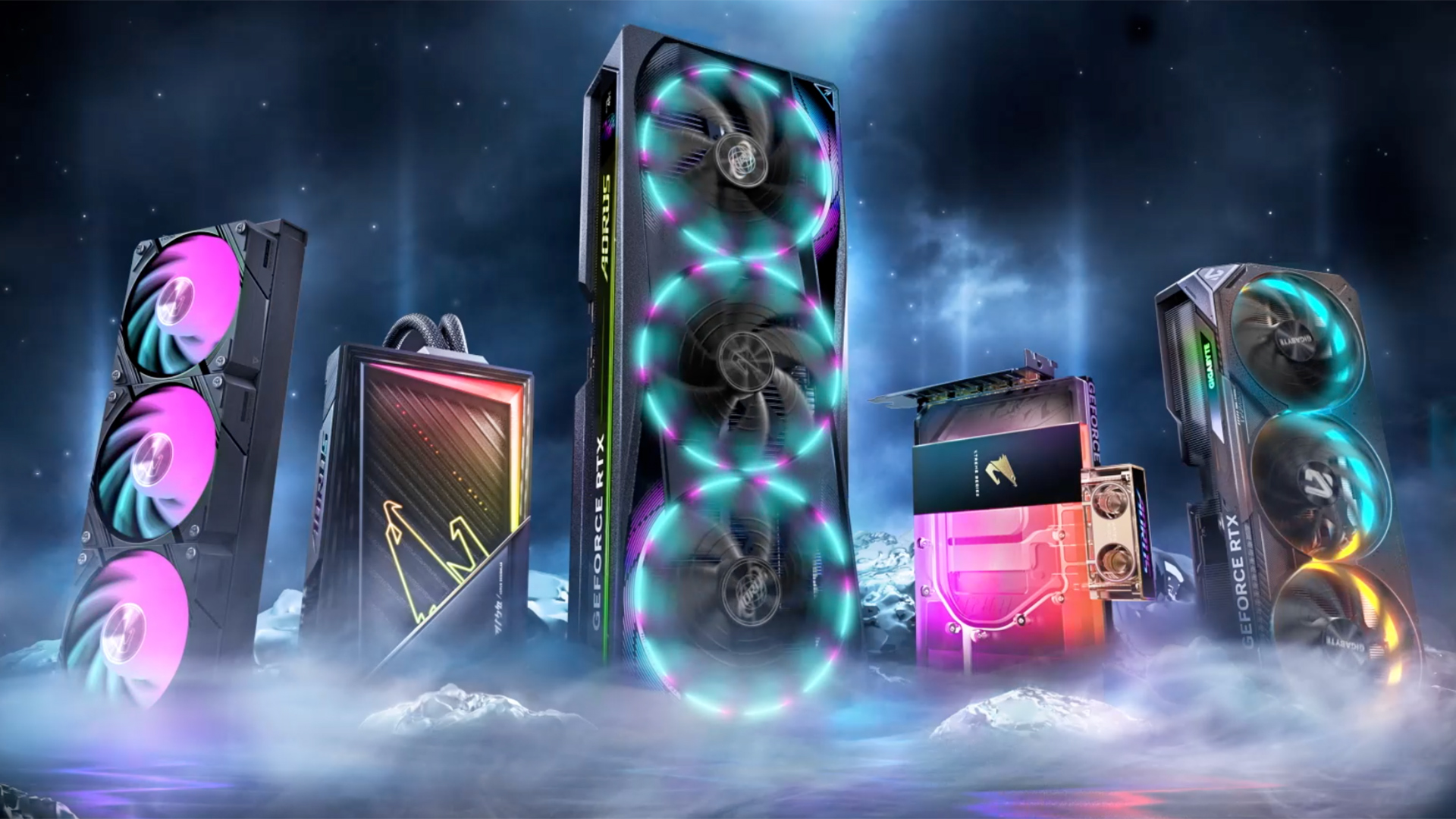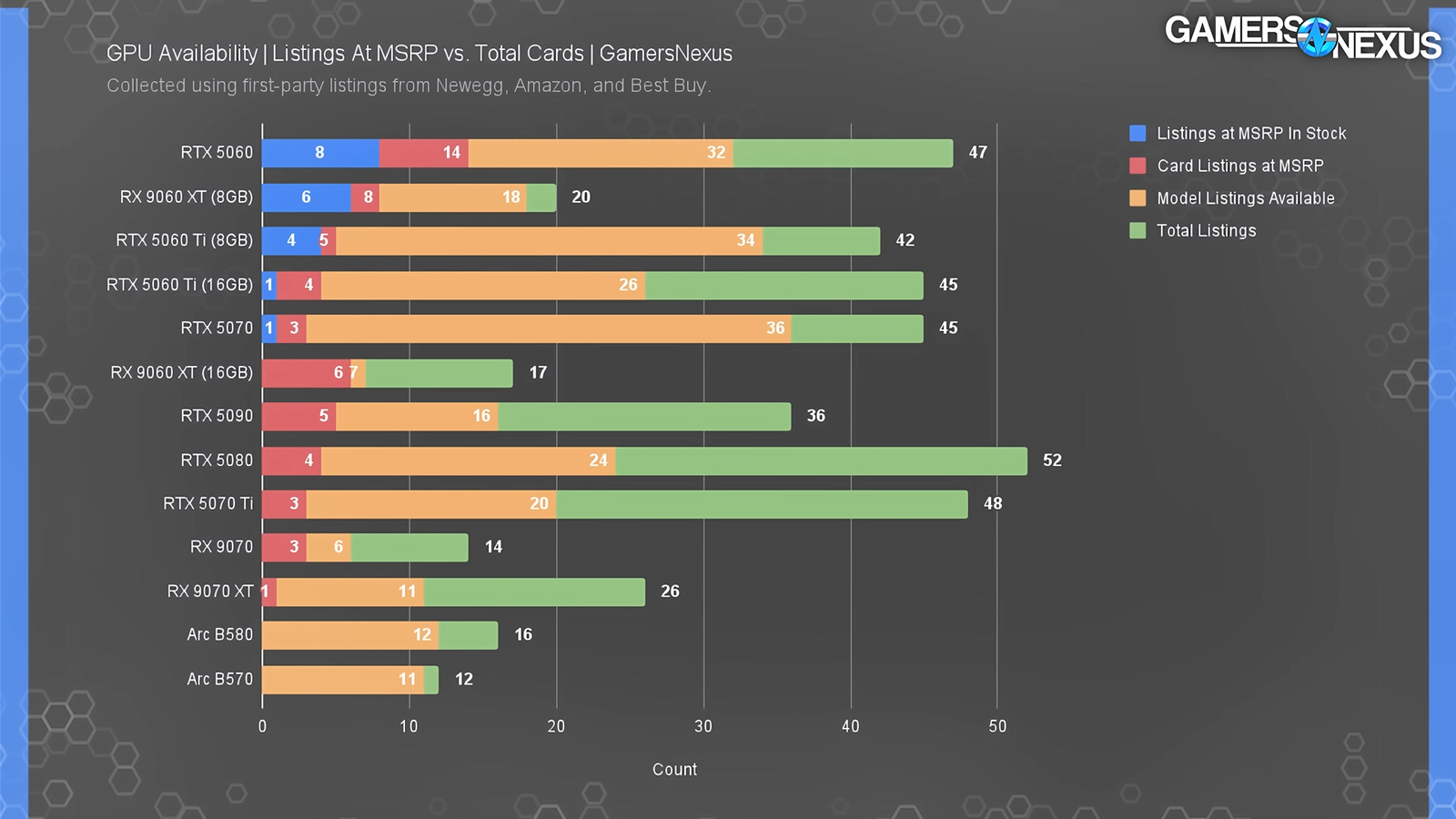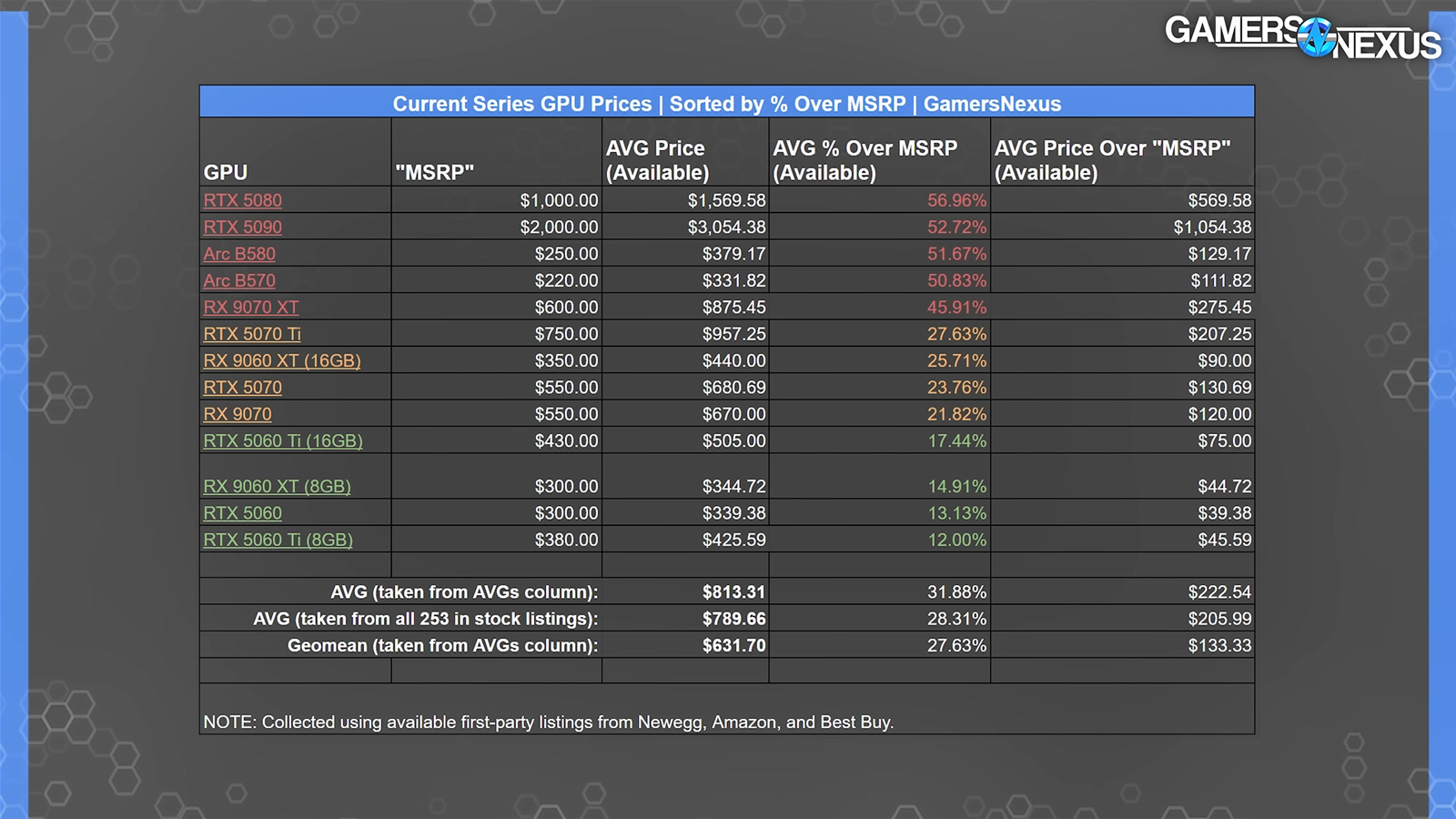Data reveals many GPUs are still selling for 50% more than MSRP — Nvidia RTX 5090 and 5080 are worst offenders
We're all being fleeced.

Many GPU buyers are hard-pressed to find a listing at MSRP nowadays, meaning you’ll have to extend your budget beyond what was announced on stage if you want to build a new PC with a modern graphics card. Unfortunately, it’s difficult to track all pricing changes, especially as these, along with stock data, rapidly evolve. Thankfully, Gamers Nexus has compiled all available data as best it could and presented the trends in a video. Gamers Nexus EIC and host Stephen Burke also said that the figures shown would likely change due to the aforementioned reasons, but that the report can serve as a baseline for anyone in the market for a new GPU.
According to Gamers Nexus, out of the 420 total listings found on Newegg, Amazon, and Best Buy, 56 were listed at MSRP, but only 20 were actually in stock. Some retailers also reportedly confirmed that a few of the unavailable MSRP listings were not coming back at the same price, meaning less than 5% of all the graphics cards listed sit at the price given on stage. It also listed the MSRPs of all current-generation cards (except for the RTX 5050), compared them to the average available price, and found that GPUs were priced about 28% higher, or a $134 premium on MSRP.

The worst offenders are the RTX 5090 and RTX 5080 GPUs, which, on average, are priced at more than 50% of the MSRP. This shows Nvidia’s monopoly of the high-end GPU market, highlighting the need for competition. Intel Arc B580 and B570 are also egregiously overpriced, with the average listing getting more than a 50% markup.
Burke noted that this was likely because one add-in board partner — Gunnir — has priced its listings so high that it’s skewing overall statistics. It’s only the RTX 5060 Ti (16GB) and all the other 8GB graphics cards that have their average selling price that is less than 20% higher than MSRP. In fact, out of the 20 GPU listings that were available at MSRP, only one — the RTX 5070 — had 16GB of VRAM.

If we’re going to go by the law of supply and demand, it seems that only a few people are buying 8GB GPUs, as seen by pricing data reflecting an average markup of just around 15%. On the other hand, mid-range GPUs — those priced between $400 and $800 — get an average markup of 25% (except for the RX 9070 XT).
Note that all these data come from the top three retailers on the market — Amazon, Newegg, and Best Buy — and that they only reflect U.S. pricing. Nevertheless, these statistics reveal that we can no longer rely on MSRP or launch pricing to determine the actual value that you will get from these GPUs in the long run.
GPU manufacturers would protest this insight, with AMD even telling the press, “It is inaccurate that $549/$599 MSRP is launch-only pricing. We expect cards to be available from multiple vendors at $549/$599 (excluding region-specific tariffs and/or taxes) based on the work we have done with our AIB partners, and more are coming. At the same time, the AIBs have different premium configurations at higher price points, and those will also continue.” However, all this information says otherwise.
Get Tom's Hardware's best news and in-depth reviews, straight to your inbox.
In reality, we would not know who to blame for this ruckus. Is it the GPU manufacturers for pricing the silicon too high and not enforcing the availability of options at MSRP? Or is it the board partners who are taking advantage of the hype and pricing their products higher than expected? Or is it the buyer, who willingly parts with their money despite not getting good value for it? But there’s one thing for sure — if you’re in the market for a current-generation graphics card right now, prepare to pay through the nose.
Follow Tom's Hardware on Google News to get our up-to-date news, analysis, and reviews in your feeds. Make sure to click the Follow button.

Jowi Morales is a tech enthusiast with years of experience working in the industry. He’s been writing with several tech publications since 2021, where he’s been interested in tech hardware and consumer electronics.
-
aberkae More like when pricing is coming down closer to MSRP steam survey reflects that people are purchasing it more. The 5090 price fell to $2499 at microcenter yesterday for the PNY oc. That's a $1000 price swing from the same retailer in 1 month time span. My 3 month prediction is becoming a reality that prices should come closer to MSRP by Black Friday.Reply
Happy 4 th of July! 😎 -
Alvar "Miles" Udell Well considering that MSRP only applies to reference editions, and most, if not all, of these are custom editions with go faster RGB and the like, MSRP doesn't apply.Reply -
ezst036 I don't understand who is buying these things.Reply
Overpriced just to get a melting connector? Clown behavior. -
russell_john Actually it is against US and EU law for Nvidia to force an AIB to sell at MSRP which should be obvious since it is the Manufacturers SUGGESTED Retail PriceReply
All Nvidia, AMD and Intel can control is the price of the IC and nothing else since that is the only component they make
The bad guys are the AIBs but nothing will change because they know consumers will blame Nvidia, the ONLY manufacturer that sells at MSRP, and not the AIBs themselves. Until Consumers put pressure on the ones at fault here, the AIBs then nothing will change because you continue to blame the wrong source -
Lamarr the Strelok Nope. It's nvidia's fault.It's possible the AIB's are trying to get more profit per card recently because nvidia charges a lot for their chip.AIB's didn't make a bunch of profit before. And ALL AIB's wouldn't know the specs or prices from nvidia until they would have a press conference. And nvidia has dumb rules for ALL their AIB's to follow. EVGA simply quit dealing with them because they were sick of it.Reply
The thing I find hard to believe are the reports from some that Jensen has no respect or consideration for the companies that put the heat sinks and other components on their boards.I consider Jensen a close to genius level engineer(?) so that actually makes me sad really. But it seems true.Trillion dollar corps make the rules and have severe penalties to those that resist. -
Notton Last I heard, AIB's have a profit margin of roughly 3~5% per graphics card they sell, and it's one of the reasons EVGA left the market.Reply
With that kind of margin, it's no wonder AIBs don't want to honor RMAs, or admit any wrong doing. -
blppt I used to upgrade every time a new generation came out. Would get the absolute top of the line model.Reply
Still using a 3090 and a 6900XT I bought back in 2020. -
blppt Reply
By then (Black Friday) we'll probably have the 5xxx refreshes, so the gouging cycle can begin anew, lol.aberkae said:More like when pricing is coming down closer to MSRP steam survey reflects that people are purchasing it more. The 5090 price fell to $2499 at microcenter yesterday for the PNY oc. That's a $1000 price swing from the same retailer in 1 month time span. My 3 month prediction is becoming a reality that prices should come closer to MSRP by Black Friday.
Happy 4 th of July! 😎
Honestly, if I was buying a new card right now, for the first time ever, I don't think I'd even consider Nvidia due to the obscene prices AND gouging on top of it. That used to be unthinkable to me---my primary box was always Nvidia GPU. -
Czbonner A lot of the American market for cards were increased by 35% because of the tarrifs on Taiwan. As much as nvidia is to blame for prices the government and current administration has fault in this as well. For example my astral 5090 was $2,799.99 at launch. It now is 3,359.99 at microcenter. That is an almost $700 increase on the $700 “Asus tax” over msrp. $1,999 (we quickly forget the titan series back in the heyday of the gtx lineup, one had an msrp of $2,999 back in 2018 and they were reference cards no AIBs)Reply
Conclusion my price was $3,646.60 out the door $1600 over msrp paid in cash
Nvidia: $1,999 msrp
Asus: $700 increase to $2,799.99
Tarrifs: $700 35% on the $1,999 cost of a FE board.
Sales tax: $250 of that (st Louis park Minnesota)
700
700
+250 = $1650 < that is the extra cash on these current prices broken down
These current prices are the shipments that were subject to tarrifs. These subsequent price drop is probably the company getting as close to their money back as possible. Since the super variants are on their way. -
Lamarr the Strelok Ok so he has %35 on Taiwan now and China is still under the 90 day delay of %145 tariffs that are coming?I've heard countless variations of them for China. It seems the AIB's and nvidia are taking more this time around and the tariffs are of course making our prices higher.Wait, do we really have tariffs on Taiwan? That seems off.Reply
The whole scene is a nightmare for all involved.
